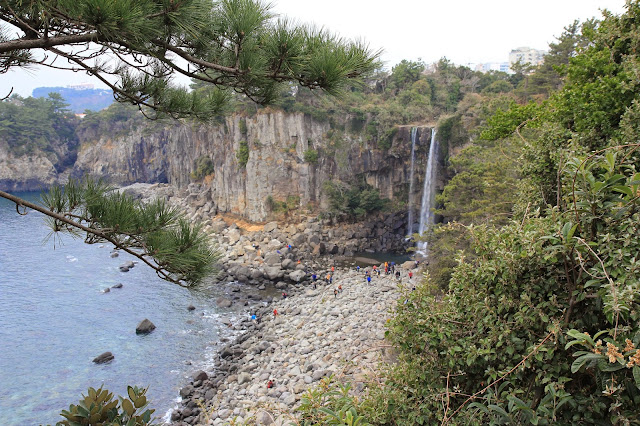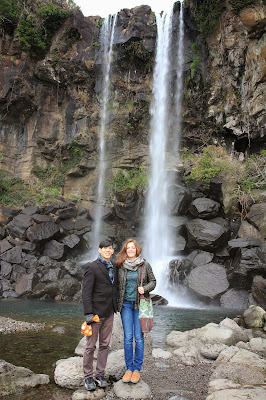 |
| A baby Japanese wild boar, or inoshishi! Seen sniffing and pissing by the roadside in Kurokawa. |
Let's fast-forward through my first evening in Kumamoto. The most exciting thing was that I ate basashi, or raw horse meat, and it was a real workout for my mandibles. Also, our hostel was jaw-droppingly gorgeous, but I will get to that later.
On Sunday morning, Erik got us a rental car and we drove northeast out of the city toward Mt. Aso (阿蘇山). Mt. Aso is Japan's largest active volcano; it sits in the middle of a
caldera that remains from several eruptions of an unimaginably large supervolcano that occurred hundreds of thousands of years ago. This caldera is no mere crater; it's so large that two towns fit comfortably inside of it (including the eponymous town of Aso). If you removed the central cone itself, the Aso caldera could comfortably fit the city of Philadelphia within its steep mountainous walls.
We took the scenic route up the sides of the caldera walls to get a view of the northern valley. As we came up on Skyline Road and Milk Road, the valley opened up beneath us. It was a bit hazy, but still quite a sight. Looking out toward Mt. Aso in the distance, it only hits you how enormous the ancient supervolcano must have been when you realize that there's another valley on the
other side of the present volcano, and that both of them used to be "underground" before it exploded.
 |
| Kurokawa, the Black River. There are pipes and hot springs on both banks, as well as decorative lights for some festival. |
 |
| New Year decorations |
Then, we drove down into the valley itself, where a few years ago there was very severe flooding. The land here is mostly used for farming, since the volcanic soil is so rich. This means that the produce here is supposedly very good, as is the dairy from local cows. Volcanic activity also means
onsen, or hot springs!
We made a pit stop at Kurokawa, which is famous for its many hot springs. Kurokawa means "Black River", and although the river that flows through the sleepy tourist town isn't black, a lot of the wood used to construct the buildings, as well as the ash in the soil, is indeed black, and it gives the place a very rustic feel.
Erik and I had dozens of hot springs to choose from and eventually chose one that was farther away from the main town. It was an outdoor spring, quite isolated and peaceful. Aah... A dip in hot sulphurous water with the sound of a river rushing by? So relaxing I could have fallen asleep in it, and while meditating a bit, almost did.
Relaxed and reinvigorated, we lunched at a famous local tofu restaurant and then took off for the volcano itself (but not before buying souvenirs, watching people make traditional
mochi (rice cakes, known as 떡 in Korean), and spotting a baby wild boar!
 |
| Mochi-making |
We finally reached the active volcano, located in the center of the caldera, and my jaw dropped when I saw plumes of white smoke (or steam?) issuing from the far-off crater. It's been a very long time since I've seen anything like that.
We then had the opportunity to drive even closer, up to the base of the crater, but we didn't take the cable car to go inside. Seeing it up close was nice enough. Later in the afternoon, the overcast weather finally cleared, which made the smoke from the volcano look just like giant cumulous clouds against a blue sky. Inspired by the volcano, I got some "ash" ice cream ("soft cream" in Japanglish) which was speckled with black sesame and licked it into the shape of a crater.
Volcanoes certainly excite me, probably because I haven't seen very many active ones in my lifetime. I've seen a lava flow in Hawaii once, but that's all I can remember. South Korea only has two volcanoes, and they're both on islands far away from the main peninsula. So, the volcanoes (and really, the entire hilly landscape) were so unexpected and new for me. It didn't look or feel anything like what I expected from Japan. The hills didn't even feel like "Asian" hills -- to me, that means steep craggy rocks of mountains densely covered in pine forests (Korea) or a tropical jungle (China and Taiwan). As we drove through dry fields and then down the mountain, I felt like we could've been somewhere in the American Midwest.
I found out from Erik that Mt. Aso erupted the day after we'd been there! It wasn't serious, just black smoke instead of white, so I sort of wish it had happened while I'd been around... Maybe next time!
 |
| Mt. Aso continually belches out steam, which looked just like the clouds on this cloudy winter day. |
On the southern side of Mt. Aso is Minamiaso, a small town also nestled inside the caldera through which runs a beautiful river called Shirakawa, the White River. This river comes from a freshwater spring that is said to produce 60 tons of water every minute.
Entrance is a buck, and visitors are allowed to drink and bottle as much water as they desire. I didn't drink any, but marveled at the water itself. It is the very defintion of pristine. You can see the loose stones at the bottom of the pool, gurgling as water and bubbles gush out from volcanic pressure, but the surface remains very calm. A rare type of underwater grass can only grow in water as clean as this.
The Shirakawa Riverhead was another peaceful, secluded place that I wanted to stay and meditate at. But there were other tourists, and it was getting late, so we left our final pit stop and drove back to Kumamoto.
Overall, the day trip was awesome, probably the highlight of my weekend in Japan. Between blasting K-pop from my phone, munching on convenience store snacks, and beholding some spectular sights, we had all the components of a great road trip and none of mishaps of a bad one. Erik was a trooper for driving, translating, and tour-guiding all day. It was a good thing that all of our activities involved engaging with nature and sort of getting away from the crowds. I was surprised and awed by a lot of what I saw that day, and it makes me want to get out of my polluted city more often to go off into the mountains. In fact, just the other day I took a hike around the Palyong Reservoir and found that the fountain at the base of the reservoir dam had frozen all of the rocks and trees around it. It was a cool find, yet another reason to get out of the house and appreciate the great outdoors.
 |
| Erik nabs some springwater; me at Shirakawa Suigen; the sparkling result of Erik's endeavor. |















































